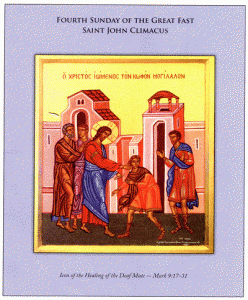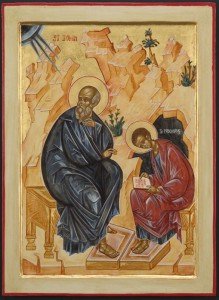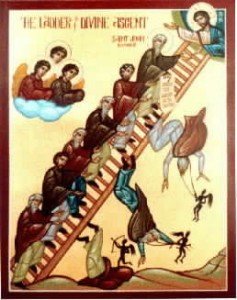O John, our leader and father, the Lord has placed you on high as a true guiding star lighting the ends of the earth with the truth of your virtue
 On this fourth weekend of the Great Fast, the Church would have us remember St. John Climacus (579-649), an Eastern Ascetic Father of the Church who wrote on the spiritual life. His main work was the Heavenly Ladder, one of the most widely used Greek handbooks of the ascetic life. Its popularity with lay as well as monastic readers is attested by the existence of 33 different illustrated Greek manuscripts as well as an uncounted number of copies without illustration. The work was translated into Latin, Syriac, Arabic, Armenian and Church Slavonic as well as a number of modern languages.
On this fourth weekend of the Great Fast, the Church would have us remember St. John Climacus (579-649), an Eastern Ascetic Father of the Church who wrote on the spiritual life. His main work was the Heavenly Ladder, one of the most widely used Greek handbooks of the ascetic life. Its popularity with lay as well as monastic readers is attested by the existence of 33 different illustrated Greek manuscripts as well as an uncounted number of copies without illustration. The work was translated into Latin, Syriac, Arabic, Armenian and Church Slavonic as well as a number of modern languages.
The Ladder, written while the author was abbot of the monastery at Mt. Sinai, shows striking psychological insight, stemming from his acute powers of observation and deep knowledge of the spiritual life. As the title indicates, the ascetic life is portrayed in the form of a ladder that the monk must ascend, each step on the ladder representing a virtue that must be acquired or a vice that must be eradicated. There are 30 steps, representing the 30 years of the hidden life of Christ, before the beginning of His public ministry.
The commemoration of St. John is paired with the Gospel story of the curing of the deaf-mute boy. The boy was brought to Jesus to be cured because, as the father shared with Jesus, your disciples were unable to expel the spirit that possessed the boy, making him mute.
As I think about St. John’s Ladder and this story of the inability of disciples to cure the deaf-mute boy, it reminds me that I too must pray and fast in order to embrace a life of self-discipline that will help me to change my heart and mind, enabling me to live more like Jesus. In order to change my attitudes – ways of thinking – and my behaviors, bringing them more into concert with those of Jesus. I must work at changing my life and not be deaf to the things the Church shares with me. The Church and the Fathers, like St. John, give us ideas about how we can go about this. We too often are deaf to their suggestions. Listen to them and put their suggestions into practice.
Let us ask God to cure of our spiritual deafness!



